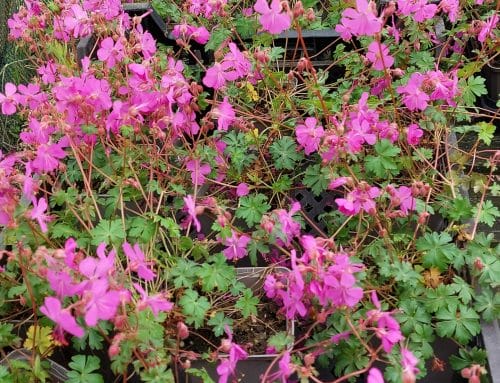There are so many geranium species suitable for any location and situation that I think it could be possible to plant a whole garden with just geraniums and have flower and foliar interest for at least 10 months of the year.
In this blog we’re going to cover clump or mound forming geraniums. Depending on the height and depth of the space you have available, and other plants around these are great for the front to the middle of the border. They’re also great space fillers and can be used as ground cover as mounds will usually join up. I find the best and quickest species for this form of geranium are the sanguineum’s and x oxonianum’s. Though be careful to avoid G. ‘Dilys’ and G. ‘Light Dilys’, while they are delightful (two of my favourites) and sanguineum hybrids, they have a more prostrate, trailing habit and will happily wend their way through your border, scrambling through all your other plants.
When trying to achieve a mound of geranium you will need to consider the light levels. If the location you intend to plant your geranium has low light levels, is in heavy shade or overcrowded by other plants it could still resort to sprawling in its endeavour to reach towards the light. If you are trying to achieve a mound form but the location has low light levels consider the nodosum or phaeum species.
Want a low clump at the front of the border? Take a look at G. ‘Tanya Rendall’ or any of the cinereum or subcaulescens groups. These create low rosettes with small silvery-green foliage, and usually have long flowering periods with bright eye catching flowers, for their diminutive size they can really pack a punch. These species do prefer a drier location.
Our own native geranium the meadow cranesbill, or in horticultural terms, geranium pratense, with its deeply dissected foliage will create large airy mounds. The pratense species comes in many varied forms with flowers and leaves in marvellous contrasting shades of purple-blue flowers with dark purple-red foliage or bright white flowers with dark red, almost black, foliage.
And if you’re really into your foliage you should definitely consider G. renardii and hybrids. The foliage is scallop edged, soft almost furry and heavily textured. G. renardii and its hybrids have relatively short flowering periods, giving it their all in spring, when the bees need it most, but they’re definitely worth it.
As I mentioned at the beginning of this post, there really is a lot to choose from when trying to pick the right geranium, fortunately this means you really can’t go too far wrong in your choice.




